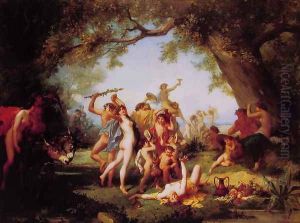Aime Gabriel Adolphe Bourgoin Paintings
Aimé Gabriel Adolphe Bourgoin, born in 1806 and passing away in 1887, was a French artist whose work, though not widely known in the contemporary mainstream, holds an intriguing place in the annals of 19th-century French art. His life and career unfolded during a period rich with artistic innovation and social change, which influenced the development and reception of his art. Bourgoin's contributions, primarily as a painter, were reflective of the broader movements of his time, yet possessed an individuality that merits recognition.
Bourgoin's early life and education in the arts were indicative of the era's typical artist's journey, with apprenticeships and academic training forming the cornerstone of his development. The specifics of his educational background remain somewhat obscure, yet it is evident that he was engaged with the artistic community in Paris, the epicenter of art and culture during the 19th century. This period was marked by the transition from Neoclassicism to Romanticism and later to Realism and Impressionism, movements that undoubtedly influenced Bourgoin's stylistic evolution.
Throughout his career, Bourgoin exhibited a keen interest in exploring various subjects, from landscapes and portraits to historical and mythological scenes. His work, characterized by a meticulous attention to detail and a vibrant use of color, garnered attention in the salons and exhibitions of the time. Despite this, Bourgoin never achieved the level of fame and recognition enjoyed by some of his contemporaries. His artistic legacy, therefore, is one of quiet perseverance and dedication to his craft, rather than widespread acclaim.
After his death in 1887, Aimé Gabriel Adolphe Bourgoin's contributions to French art gradually faded from the public consciousness, and today he is remembered by a niche group of art historians and enthusiasts. The scarcity of comprehensive records on his life and work has posed challenges to those wishing to study his contributions in depth. However, the surviving pieces of his oeuvre continue to offer insight into the diverse and dynamic artistic landscape of 19th-century France. Bourgoin's story is a testament to the many artists of his time who pursued their passion for art with steadfast resolve, despite the shifting sands of public taste and the often-elusive promise of enduring fame.
